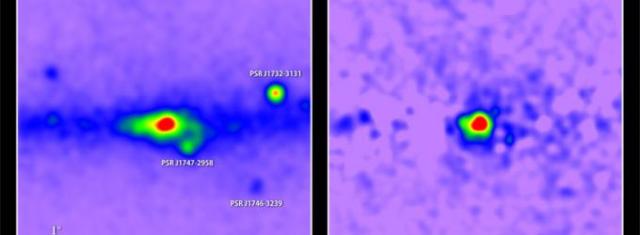Apr 4 2014
A new study of gamma-ray light from the center of our galaxy makes the strongest case to date that some of this emission may arise from dark matter, an unknown substance making up most of the material universe. Using public data from NASA's Fermi Gamma-ray Space Telescope, independent scientists at the Fermi National Accelerator Laboratory (Fermilab), the Harvard-Smithsonian Center for Astrophysics (CfA), the Massachusetts Institute of Technology (MIT) and the University of Chicago have developed new maps showing that the Galactic center produces more high-energy gamma rays than can be explained by known sources and that this excess emission is consistent with some forms of dark matter.
 Map of gamma rays
Map of gamma rays
"The new maps allow us to analyze the excess and test whether more conventional explanations, such as the presence of undiscovered pulsars or cosmic-ray collisions on gas clouds, can account for it," said Dan Hooper, an astrophysicist at Fermilab and a co-author of the study. "The signal we find cannot be explained by currently proposed alternatives and is in close agreement with the predictions of very simple dark matter models."
"We're working hard to come up with ways to confirm whether or not this signal is indeed from dark matter," said co-author Douglas Finkbeiner, a Harvard professor of astronomy and physics at CfA.
The center of the Milky Way teems with gamma-ray sources, from interacting binary systems and isolated pulsars to supernova remnants and particles colliding with interstellar gas. It's also where astronomers expect to find the Galaxy's highest density of dark matter, which only affects normal matter and radiation through its gravity. Large amounts of dark matter attract normal matter, forming a foundation upon which visible structures, like galaxies, are built.
No one knows the true nature of dark matter, but WIMPs, or Weakly Interacting Massive Particles, represent a leading class of candidates. Theorists have envisioned a wide range of WIMP types, some of which may either mutually annihilate or produce an intermediate, quickly decaying particle when they collide. Both of these pathways end with the production of gamma rays -- the most energetic form of light -- at energies within the detection range of Fermi's Large Area Telescope (LAT).
When astronomers carefully subtract all known gamma-ray sources from LAT observations of the Galactic center, a patch of leftover emission remains. This excess appears most prominent at energies between 1 and 3 billion electron volts (GeV) -- roughly a billion times greater than that of visible light -- and extends outward at least 5,000 light-years from the Galactic center.
Hooper and his colleagues conclude that annihilations of dark matter particles with a mass between 31 and 40 GeV provide a remarkable fit for the excess based on its gamma-ray spectrum, its symmetry around the galactic center, and its overall brightness. Writing in a paper submitted to the journal Physical Review D, the researchers say that these features are difficult to reconcile with other explanations proposed so far, although they note that plausible alternatives not requiring dark matter may yet materialize.
"Dark matter in this mass range can be probed by direct detection and by the Large Hadron Collider (LHC), so if this is dark matter, we're already learning about its interactions from the lack of detection so far," said co-author Tracy Slatyer, a theoretical physicist at MIT. "This is a very exciting signal, and while the case is not yet closed, in the future we might well look back and say this was where we saw dark matter annihilation for the first time."
The researchers caution that it will take multiple sightings -- in other astronomical objects, the LHC or in some of the direct-detection experiments now being conducted around the world -- to validate their dark matter interpretation.
"Our case is very much a process-of-elimination argument. We made a list, scratched off things that didn't work, and ended up with dark matter," said Finkbeiner.
This release is being issued jointly with the NASA Goddard Space Flight Center.
Headquartered in Cambridge, Mass., the Harvard-Smithsonian Center for Astrophysics (CfA) is a joint collaboration between the Smithsonian Astrophysical Observatory and the Harvard College Observatory. CfA scientists, organized into six research divisions, study the origin, evolution and ultimate fate of the universe.
For more information, contact:
Francis Reddy
NASA/Goddard Space Flight Center
301-286-4453
[email protected]
David A. Aguilar
Director of Public Affairs
Harvard-Smithsonian Center for Astrophysics
617-495-7462
[email protected]
Christine Pulliam
Public Affairs Specialist
Harvard-Smithsonian Center for Astrophysics
617-495-7463
[email protected]